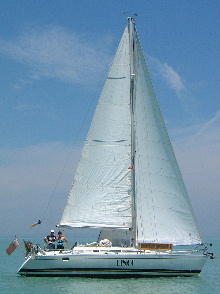
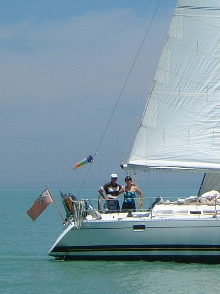

A record of the Altwasser family's sailing experiences in their yacht Bingo
Posted
by Richard at 3:58 PM
Cartagena to Mallorca
March 24th to April 1st 2004. 233 nautical miles.



Cartagena to Torrevieja. March 24th.
Cartagena is starting to present its rich history to tourists. In 2003 four sites were opened: the Castle; a section of Roman road and corner of the Roman baths; the Roman Temple dedicated to the worship of Ceasar Augustus and, most ancient of all, a section of the city wall. The wall was built by the Carthaginians to connect the naturally protective hills surrounding this city of “Qart-Hadast” (New City) which Hasdrubal had founded in 220BC. The wall was to defend against the Romans in the aftermath of the first Punic war. In 2004 four more sites will open.
On Wednesday morning we left Cartagena shortly after 8 am and sailed East past the uninhabited rocky cliffs of Escombreras and Cabo Negrete towards Cabo de Palos. By mid-day we rounded the Palos lighthouse where isolated rocks extend the line of the peninsula towards the Hormigas islands, some two miles offshore. The wind picked up from the East and filled our sails as we turned north. 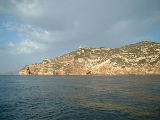
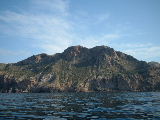
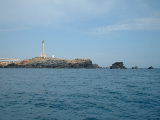
La Manga, famous now as a rich person’s holiday playground and sprawling with high rise hotels, is a sand bar 12 miles long and in places only a few hundred yards wide. It protects the 6 mile wide Mar Menor inland sea. As we sailed North past this low, flat, sandy and densely packed coastline, the wind increased. Military jet training aircraft swooped and dived overhead, rolled and tumbled out of the sky and landed at San Javier airport as we passed Punta del Estacio, the entrance point to the inland Mar and reefed our sails in a rising wind and swell. Within an hour we had less than a third of our sail area achieving a mighty 7 knots with swell building uncomfortably. Our original target, the pretty port at Santa Pola, was still four hours distant, but discretion being the better part of valour, we headed instead for the closer, larger and well protected harbour of Torreviejo.
Torrevieja. March 25th - 29th .
The weather worsened into the weekend with rain and gales. We were delighted to meet with Brian and Shirley (Airwave) who taught us how to win the quiz night in a local bar.
Torreviejo was founded in the 18th Century to exploit the Salinas, salt lagoons, just a kilometre behind the shoreline. The town is now driven by the export of salt and import of British tourists. The Museo Salinas has interesting models of sailing galleons, built from balsa and string, about a metre long, then repeatedly dipped in the salty lagoon and dried in the sun, so that they are entirely encrusted in salt crystals.
The bad weather passed through early on Monday morning and by late afternoon gentle SW winds brought warmer air and the Spanish, German and Icelandic weather website oracles we regularly consult all agreed on at least three days of SW 3- 5. We removed the sail cover and set our alarm for 5 am.
Torrevieja to Morayra. March 30th.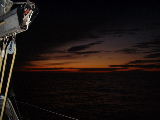
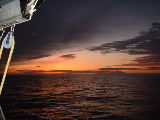

The drama of sunrise over an open East facing sea cannot be captured by a camera which automatically adjusts shutter speed with light intensity. Not only does the light build, slowly at first then with a rapid crescendo as the first direct rays break the horizon, but the heat builds too. An hour before sunrise on a starless morning all is darkness, lights can be distinguished on the shoreline, fishing boats at sea and the uneven cycle of two flashes, a pause then a further flash every twenty seconds identifies Cabo de Santa Pola. Distances are difficult to judge, sea state is felt not seen. Thirty minutes later, the waves are revealed, seabirds are visible and the sky in the East is red with promise. Then all is warmth and brightness, layers of clothing are stripped off, sunglasses donned, navigation lights extinguished and books brought on deck for morning study. 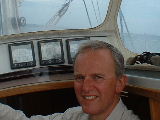
By mid afternoon we passed from West to East, crossing the Greenwich Meridian ten months after first crossing in a westerly direction in thick fog off the Normandy coastline.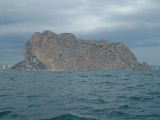
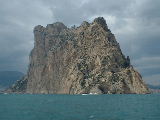
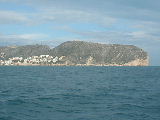
The craggy headland of Punta Ifach, rising like a small mountain, was visible all afternoon as a waypoint an hour from our target port of Morayra. At 5:15 we entered port, having logged a massive 63 miles. In a busy evening we did the laundry, filled with diesel and water, replaced our Camping Gas and still found time to chat with friendly locals. We heard a story of one yacht that apparently had been “shipwrecked” in Palma over the winter when a freak wave washed a BMW off the quayside onto the boat. We made a mental note never to tie up next to a parked BMW. We were offered the use of a bicycle to climb the steep hill into town and then warned it had no brakes. We reset the alarm for 5 am and fell asleep.
Morayra to San Antonio, Ibiza. March 31st.
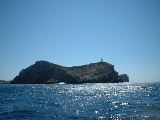
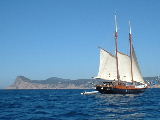
We left Morayra in darkness and looked back to the West as dawn broke on the three capes of Nao, San Antonio and San Martin, the most westerly points where the Costa Blanca and Costa del Azahar reach out towards the Balearics, with the peak of Monte Mongo still dark. The horizontal white line of cumulus remained a visible marker of the mainland for several hours after the rocky headlands disappeared into the haze. Liz’s new tinted distance spectacles enabled her to spot Ibiza before morning coffee and prove that the dark spot on the horizon that I had been pointing to was just a ship in a different direction after all.
The pilot book describes a route inland of the Conejeras islands just NW of Ibiza, but we went the extra mile and took the outer track. As we rounded the largest, Isla Conejera itself, a 60 foot wooden gaff rigged schooner appeared in the bay of San Antonio. We raced ahead for a closer look. The class of little children on deck, each in a bright orange lifevest, shouted “Bingo” as we sailed past. In the bay we picked up a swing mooring next to Robert and Sarah’s “Yansa” . Well spotted again Liz’s new spectacles! Despite lack of practice, Liz wielded the boathook with effortless skill and picked up the mooring at first attempt. Once secure, I stepped forward to rig a second safety line through the same buoy and managed twice to drop the boathook in the sea and to split the shaft. Again we set the alarm for 5 am.
Ibiza to Santa Ponsa, Mallorca. April 1st.
Thursday must have been our best day of sailing ever. Eleven hours with 8 – 12 knots of wind on the beam, averaging 6 knots hull speed and sea state slight becoming smooth. Sun and wind burned us gently. Just like all the ads for sailing holidays.
In 1229 the combined mainland fleets of Catalonia and Aragon, under the command of King Jaime I landed an army in the SW corner of Mallorca to evict the Moors. A large stone cross on the south side of the bay of Santa Ponsa commemorates the landing. An attractive natural rocky inlet, sitting under the monument is protected from the sea by a breakwater and since 1975 has been home to the Club Nautico, considered by many to be the most attractive yacht harbour in Mallorca. We have booked here for a month. Ben and Ruth will join us for Easter and the Altwasser grandparents arrive later in April. We chose this spot because it is the nearest to Ibiza, but after a few days settling in we consider that King Jamie made a good choice. The staff are friendly, the harbour is quiet and very clean and we can get chocolate muesli for breakfast.